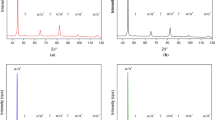Abstract
To find the optimal Quenching and Partitioning (Q&P) process parameters of low-alloy wear resistant steel, various Q&P processes including quenching temperature, partitioning temperature and partitioning time were designed and tested by using orthogonal experiment method. Through analysis of orthogonal experiment, quenching temperature was the most important influential factor on the impact toughness and hardness, and partitioning time played a critical role on tensile strength. The optimal Q&P heat treatment parameters of low alloy wear resistant steel were partitioning at 350 °C for 10 min immediately after quenching at 100 °C. The microstructure of samples was composed of martensite laths and retained austenite. The relative volume fraction of retained austenite increased with the increase of quenching temperature and decreased gradually with the lengthening of partitioning time. Combining the results of Energy dispersive spectrometer, the reason for decrease of retained austenite was the existence of carbide precipitation and the carbide was (Fe, Cr)3C7. Compared to the traditional heat treatment of quenching and low temperature tempering, the samples under Q&P treatment displayed higher toughness and maintained relatively high tensile strength and wear resistance.






Similar content being viewed by others
References
Y. Lyu, Y. Zhu, and U. Olofsson: Wear between wheel and rail: A pin-on-disc study of environmental conditions and iron oxides. Wear 328–329, 227–285 (2015).
Y-N. Pan, W-S. Chang, and R-M. Chang: Optimal heat treatment conditions and properties of bimetal (high Cr cast iron alloyed steel) hammers. Int. J. Cast Met. Res. 21, 71–75 (2008).
X. Tao, L. **aoman, and Y. Cuiyan: Influence of rare earth on wear resistance of wear resistant cast iron containing low alloy. J. Rare Earths 22, 139–142 (2004).
S. Matas and R.F. Hehemann: Retained austenite and the tempering of martensite. Nature 87, 685–686 (1960).
X.D. Wang, N. Zhong, Y.H. Rong, and Z.Y. Xu: Novel ultrahigh-strength nanolath martensitic steel by quenching-partitioning-tempering process. J. Mater. Res. 24, 260–267 (2009).
J. Speer, D.K. Matlock, B.C. De Cooman, and J.G. Schroth: Carbon partitioning into austenite after martensite transformation. Acta Mater. 51, 2611–2622 (2003).
R.D.K. Misra, H. Zheng, K.M. Wu, and L.P. Karjalainen: Niobium-containing quenching and partitioning processed ultrahigh strength martensite–austenite dual phase steels. Mater. Sci. Eng., A 579, 188–193 (2013).
B.V. Rao and G. Thomas: Transmission electron microscopy characterization of dislocated “lath” martensite. In Proceedings of the International Conference on Martensitic Transformations-79 (MIT: Boston, 1979); pp. 12–16.
M. Sarikaya and G. Thomas: Lath martensites in carbon steels are they bainitic. In Proceedings of an International Conference on Solid to Solid Phase Transformations (TMS-AIME: Cambridge, 1982); pp. 999–1004.
X. Zuyao and L. Xuemin: Diffusion of carbon during the formation of low-carbon martensite. Scr. Mater. 17, 1285–1288 (1983).
J.G. Speer, D.V. Edmonds, F.C. Rizzo, and D.K. Matlock: Partitioning of carbon from supersaturated plates of ferrite, with application to steel processing and fundamentals of the bainite transformation. Curr. Opin. Solid State Mater. Sci. 8, 219–237 (2004).
D.V. Edmonds, K. He, E.C. Rizzo, B.C. De Cooman, D.K. Matlock, and J. Speer: Quenching and partitioning martensite–A novel steel heat treatment. Mater. Sci. Eng., A 438, 25–34 (2006).
S. Chatterjee, H.-S. Wang, J.R. Yang, and H.K.D.H. Bhadeshia: Mechanical stabilisation of austenite. Mater. Sci. Technol. 22, 645 (2006).
C.G. Lee, S.J. Kim, T.H. Kim, and S. Lee: Effects of volume fraction and stability of retained austenite on formability in a 0.1C–1.5Si–1.5Mn–0.5Cu TRIP-aided cold-rolled steel sheet. Mater. Sci. Eng., A 371, 16 (2004).
K. Zhang, M. Zhang, Z. Guo, N. Chen, and Y. Rong: A new effect of retained austenite on ductility enhancement in high-strength quenching–partitioning–tempering martensitic steel. Mater. Sci. Eng., A 528, 8486–8491 (2011).
N. Zhong, X.D. Wang, L. Wang, and Y.H. Rong: Enhancement of the mechanical properties of a Nb-microalloyed advanced high-strength steel treated by quenching–partitioning–tempering process. Mater. Sci. Eng., A 506, 111–116 (2009).
L. Xu, Z. Yan, Y. Liu, and H. Li: Microstructure evolution and martensitic transformation behaviors of 9Cr–1.8W–0.3Mo ferritic heat-resistant steel during quenching and partitioning treatment. J. Mater. Res. 28, 2835–2843 (2013).
J. Mola and B.C. De Cooman: Quenching and partitioning (Q&P) processing of martensitic stainless steels. Metall. Mater. Trans. A 44, 946–967 (2013).
N. Maheswari, S. Ghosh Chowdhury, K.C. Hari Kumar, and S. Sankaran: Influence of alloying elements on the microstructure evolution and mechanical properties in quenched and partitioned steels. Mater. Sci. Eng., A 600, 12–20 (2014).
GB/T 228.1-2010: Metallic Materials-Tensile Testing at Ambient Temperature (China Standard Press, Bei**g, 2011).
GB/T 229-2007: Metallic Materials-Charpy Pendulum Impact Test Method (China Standard Press, Bei**g, 2007).
GB/T 230.1-2009: Metallic Materials-Rockwell Hardness Test-Part 1: Test Method (China Standard Press, Bei**g, 2009).
L. Zhao, N.H. Van Dijk, E. Brück, J. Sietsma, and S. Van der Zwaag: Magnetic and X-ray diffraction measurements for the determination of retained austenite in TRIP steel. Mater. Sci. Eng., A 313, 145–152 (2001).
GB/T 12444-2006: Metallic Materials-Wear Test Method-Block-on-Ring Sliding Wear Test (China Standard Press, Bei**g, 2006).
G. Krauss: Steel: Heat Treatment and Processing Principles (ASM International Metals Park, OH, USA, 1990).
S.S. Nayak, R. Anumolu, R.D.K. Misra, K.H. Kim, and D.L. Lee: Microstructure–hardness relationship in quenched and partitioned medium-carbon and high-carbon steels containing silicon. Mater. Sci. Eng., A 8, 442–456 (2008).
Author information
Authors and Affiliations
Corresponding author
Rights and permissions
About this article
Cite this article
Zhou, W., Sun, Y., Wang, Q. et al. Effect of quenching and partitioning process to low-alloy wear resistant steel. Journal of Materials Research 31, 663–669 (2016). https://doi.org/10.1557/jmr.2016.58
Received:
Accepted:
Published:
Issue Date:
DOI: https://doi.org/10.1557/jmr.2016.58




